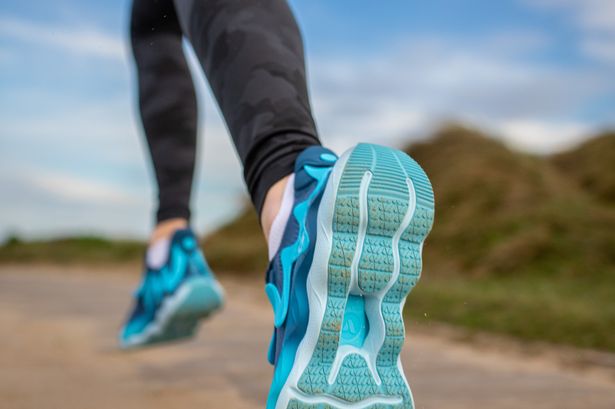As new research reveals that women’s athletic footwear doesn’t meet the needs of female feet, meet the husband and wife team transforming trainers
It might seem that women are spoiled for choice when it comes to choosing trainers, whether they’re buying a pair of fashion ‘sneakers’ in any possible colour from hot pink to leopard print or investing in technical shoes promising to boost performance.
But according to new research, this array of supposedly beneficial footwear isn’t aimed at the fairer sex at all – they’re simply men’s trainers that have been reduced in size.
The result is that women are not only at greater risk of discomfort, but they are also more likely to be injured and suffer from painful conditions such as plantar fasciitis.
In the paper, recently published in BMJ Journals’ Open Sport & Exercise Medicine, Canadian researchers noted that “billions of dollars have been invested by the footwear industry over the last 50 years to incorporate technology aiming to prevent injury, maximise comfort and improve performance in running.”
However, the team led by Simon Fraser University in Canada continued, “research conducted by industry and academic communities to inform running footwear development has predominantly been designed for and tested on males or men.”
The paper explains that running shoes are designed by creating a “last”, which is a three-dimensional foot-shaped mould based on male foot anatomy. This is then scaled for the full range of sizes for men and women.
“Beyond making the shoes smaller and changing the colour – a process known as ‘shrink it and pink it’ – often only minimal modifications are made to create women’s shoes,” the researchers state. The academics concluded that, “women runners have distinct and evolving footwear needs that are currently unmet by the running footwear industry.”
While this may come as a shock to many women – and even sparked a lively discussion on ITV’s This Morning it’s old news to husband and-wife team Nicolle and Martin Dean from St Albans, Hertfordshire, who spent five years developing an athletic shoe specifically designed for women’s feet and anatomy.
In September they launched QLVR Running Slippers, a trainer that is engineered at every stage specifically for women. They were driven by the thought, “what if women’s athletic shoes were actually designed for women’s feet?” “For too long, the athletic footwear industry has been treating women’s feet as shrunk down versions of men’s even though the biomechanics and shape are very different,” says Nicolle, 52. “Poorly fitting trainers can lead to injuries. Anatomically, women have a wider hip-to-knee angle, which can be a factor in ligament strain, along with hormonal changes, which is why specific stability and alignment is essential when engineering a shoe for women’s running and training.”
Martin, a fourth-generation shoemaker, and Nicolle – parents of two teenage girls – saw how women were being sidelined by the industry. “The standard approach was ‘shrink it and pink it’. It’s cheaper to share moulds, lasts and cutting dies across genders. We decided women deserved better than wearing small men’s shoes.
“But the real revelation was proving that women’s feet aren’t just smaller versions of men’s feet. Higher arches, wider toe boxes, narrower heels – we engineered for the real shape, not the convenient one.”
It took the Deans five years to research their groundbreaking Running Slipper, £165, during which time they raised £100,000 in a Kickstarter campaign.
Their design is made from female-specific lasts. They’ve also jettisoned shoelaces for a patented “Wing Fit” system, inspired by the movement of birds’ wings, which makes the trainers flexible enough to slip on but then provide support over the whole shoe – not just at the bridge of the foot where the laces have been tightened.
Nicolle says: ‘When you step into our QLVR Running Slipper, your foot is instantly locked in as the heel area wraps around the foot for support and stability, holding the foot in correct alignment while allowing natural flex and motion.”
Olympian Dame Kelly Holmes is already a fan, crediting QLVR trainers with helping her come back from injury, and Davina McCall has also been seen wearing hers.
Meanwhile, in elite women’s sport, things are changing, with Adidas releasing the F50 Sparkfusion, their first football boot designed specifically for the female anatomy, as well as the RS15 Avaglide, its first female-first rugby boot, in June. “We are challenging the industry and revolutionising athletic footwear through women-first design and laceless technology,” Nicolle says. “There’s no bigger compliment than seeing women putting them to work and benefitting from our unique design.”
Five signs your trainers don’t fit properly:
Nicolle Dean shares the clues that your footwear isn’t right for you:
SLIDING IN THE SHOE If your foot is sliding back and forth inside the shoe, it’s not holding correctly at the heel. Your foot should be held snugly at the back and midfoot.
BLISTERS No, blisters aren’t just a fact of life. Rubbing and discomfort caused by ‘heel slip’ shows that the heel area is loose and the back of your foot is not being supported. Blisters are common for women runners as their heels are narrower than men’s.
BASHED-UP TOES Do you have runner’s toe? These bruised toenails aren’t a badge of honour – they’re a sign that your toes are banging the front of the shoe. Your foot should be held securely in position.
NUMBNESS OR TINGLING Have you ever noticed that your toes start to tingle or feel numb when you run? This is because they’re being pinched, often because the men’s trainer shape is too narrow in the toebox.
Source: Mirror

Leave a Reply